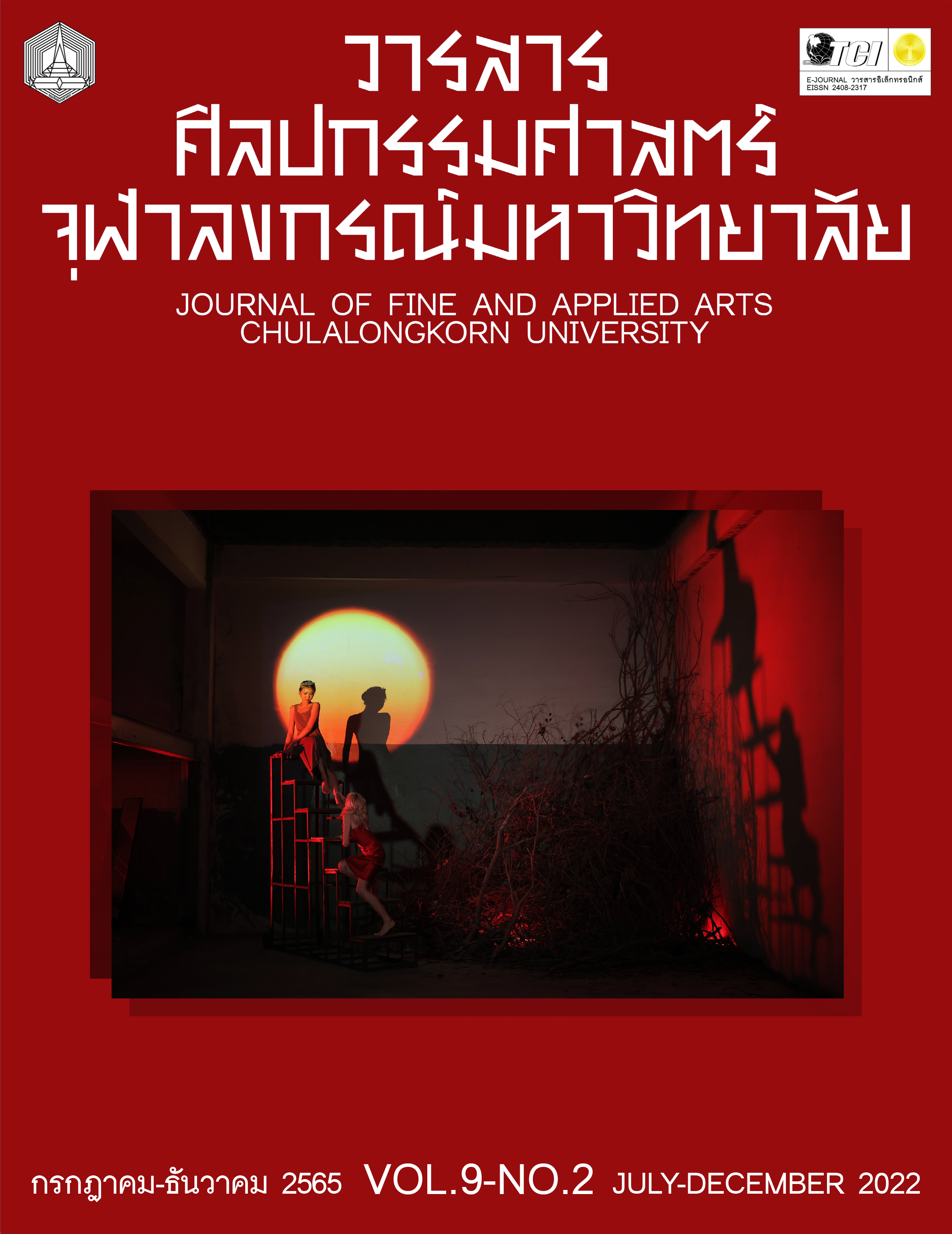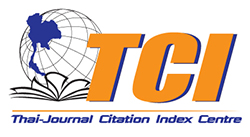การพัฒนากิจกรรมดนตรีสำหรับเด็กออทิสติกเพื่อการพัฒนาทักษะทางสังคม
คำสำคัญ:
กิจกรรมดนตรี , เด็กออทิสติก, ด้านปฏิสัมพันธ์ทางสังคม, ทักษะทางสังคม, การสื่อสาร, ความสนใจและการทำซ้ำบทคัดย่อ
วัตถุประสงค์ของบทความวิจัยนี้ เพื่อศึกษาพัฒนาแผนการจัดกิจกรรมดนตรีสำหรับเด็กออทิสติก และเพื่อศึกษาเปรียบเทียบทักษะทางสังคมของเด็กออทิสติกก่อนและหลังการใช้แผนการจัดกิจกรรมดนตรี มูลนิธิเด็กออทิสติกไทยกรุงเทพมหานคร กลุ่มเป้าหมายในการวิจัยครั้งนี้ คือ เด็กออทิสติก อายุ 6-11 ปี จำนวน 6 คน ซึ่งได้ใช้วิธีการคัดเลือกแบบเจาะจง โดยทางครูประจำชั้นเป็นผู้คัดเลือก เครื่องมือที่ใช้ในการวิจัยครั้งนี้ คือ แผนการจัดกิจกรรมดนตรีสำหรับเด็กออทิสติก จำนวน 8 แผน และแบบประเมินพฤติกรรมเด็กออทิสติก จำนวน 40 ข้อ
ผลการวิจัยพบว่า แผนการจัดกิจกรรมดนตรีสำหรับเด็กออทิสติก จำนวน 8 แผน ยึดหลักการพัฒนากิจกรรมดนตรีใน 3 ประเด็น ได้แก่ การสำรวจเกี่ยวกับพื้นที่รอบ ๆ ตัวเอง การสำรวจเกี่ยวกับรูปร่างลักษณะ และการเลียนแบบสู่การสร้างสรรค์ ลักษณะกิจกรรมดนตรี ประกอบด้วย 3 ขั้น ได้แก่ ขั้นนำ เป็นการนำเข้าสู่กิจกรรม สร้างความสนใจ สมาธิ และสร้างความคุ้นเคยให้กับเด็กก่อนเข้าสู่กิจกรรม ขั้นการเรียนรู้และปฏิบัติซ้ำ เป็นการเปิดโอกาสให้เด็กสามารถเลียนแบบพฤติกรรม ท่าทาง การออกเสียง เปล่งเสียง หรือฟังระดับเสียง ต่าง ๆ ตามผู้นำกิจกรรม และจะให้เด็กได้ปฏิบัติกิจกรรมอย่างต่อเนื่องพร้อมฝึกฝนหรือปฏิบัติซ้ำ ๆ และขั้นคิดสร้างสรรค์และสรุปกิจกรรม เด็กออทิสติกจะได้แสดงออกอย่างอิสระ ในการสร้างสรรค์ท่าทางประกอบเพลง การเคาะจังหวะเครื่องดนตรีในรูปแบบต่าง ๆ รวมถึง การแสดงความรู้สึกที่มีต่อกิจกรรมดนตรีในแต่ละครั้ง และผลการใช้กิจกรรมดนตรีในการพัฒนาทักษะทางสังคมของเด็กออทิสติก พบว่า เด็กออทิสติกมีทักษะทางสังคมในทุกด้านหลังการใช้กิจกรรมดนตรีสูงกว่าก่อนการใช้กิจกรรมดนตรีอย่างมีนัยสำคัญทางสถิติที่ระดับ .01
เอกสารอ้างอิง
กรมสุขภาพจิต กระทรวงสาธารณสุข. “สำรวจโลกของเด็กออทิสติก.” https://www.dmh.go.th/news-dmh/view.asp?id=31178.
ณรุทธ์ สุทธจิตต์. “จิตวิทยาการสอนดนตรี.” วารสารเพลงดนตรี ข่าวสารเพลงดนตรี ปีที่ 1, ฉบับที่ 3 (กันยายน 2537): 64-69.
ทวีศักดิ์ สิริรัตน์เรขา. การบำบัดทางเลือกในเด็กพิเศษ. กรุงเทพฯ : โรงพิมพ์คุรุสภาลาดพร้าว, 2550.
ธวัชชัย นาควงษ์. การสอนดนตรีสำหรับเด็กตามแนวของคาร์ลออร์ฟ. กรุงเทพฯ : ภาควิชาศิลปะนิเทศ คณะมนุษยศาสตร์ มหาวิทยาลัยเกษตรศาสตร์, 2542.
ปาหนัน กฤษณรมย์. “ผลของกิจกรรมดนตรีบำบัดต่อความสามารถในการรับรู้และตอบสนองต่อดนตรีพัฒนาการและคุณภาพชีวิตของเด็กออทิสติก.” วารสารปาริชาต มหาวิทยาลัยทักษิณ ปีที่ 33, ฉบับที่ 2 (พฤษภาคม-สิงหาคม 2563): 169-181.
รวมศักดิ์ เจียมศักดิ์. “แนวทางการจัดกิจกรรมดนตรีบำบัดสำหรับเด็กพิเศษผ่านกระบวนการจัดการเรียนรู้.” วารสารวิชาการมนุษยศาสตร์และสังคมศาสตร์ มหาวิทยาลัยราชภัฏพระนครศรีอยุธยา ปีที่ 8, ฉบับที่ 1 (มกราคม-มิถุนายน 2563): 85-112.
โรงพยาบาลราชวิถี. “เร่งวิจัย “ยีน” ต้นเหตุโรคออทิสติก คาดเด็กไทยป่วย 3 แสนคน.”https://www.rajavithi.go.th/rj/?p=5151.
วรานิษฐ์ พิชิตยศวัฒน์. “ประสิทธิผลของกิจกรรมดนตรีบำบัดต่อพัฒนาการทางสื่อความหมายและปฏิสัมพันธ์ของเด็กออทิสติก.” วิทยานิพนธ์ปริญญาบริหารธุรกิจมหาบัณฑิต, มหาวิทยาลัยหอการค้าไทย, 2555.
วารุณี สกุลภารักษ์ และวรรณอาภา หฤทัยงาม. “ดนตรีและกิจกรรมเคลื่อนไหวสำหรับเด็กปฐมวัย.” วารสารวชิรเวชสารและวารสารเวชศาสตร์เขตเมือง ปีที่ 63, ฉบับที่ 3 (พฤษภาคม-มิถุนายน 2562): 203-208.
วาสนา สาระจันทร์. “การจัดการเรียนรู้วิชาดนตรี ตามแนวคิดของคาร์ลออร์ฟร่วมกับกระบวนการแก้ปัญหา เพื่อพัฒนาทักษะการปฏิบัติทางดนตรีและทักษะความคิดริเริ่มสร้างสรรค์และนวัตกรรมสาหรับนักเรียนชั้นมัธยมศึกษาตอนปลาย.” วิทยานิพนธ์ปริญญาศึกษาศาสตรมหาบัณฑิต, มหาวิทยาลัยธุรกิจบัณฑิตย์, 2561.
Boxill, Edith Hillman. Music therapy for the developmentally disabled. Rockville, Md.: Aspen Systems Corp., 1985.
Liisa, Henriksson Macaulay. The music miracle: The scientific secret to unlocking young child’s full potential. London: Earnest House, 2014.
ดาวน์โหลด
เผยแพร่แล้ว
ฉบับ
ประเภทบทความ
สัญญาอนุญาต
ลิขสิทธิ์ (c) 2022 NUTTIKA SOONTORNTANAPHOL

อนุญาตภายใต้เงื่อนไข Creative Commons Attribution-NonCommercial-NoDerivatives 4.0 International License.
ลิขสิทธิ์ของบทความเป็นของเจ้าของบทความ บทความที่ได้รับการตีพิมพ์ถือเป็นทัศนะของผู้เขียน
กองบรรณาธิการไม่จำเป็นต้องเห็นด้วยและไม่รับผิดชอบต่อบทความนั้น






